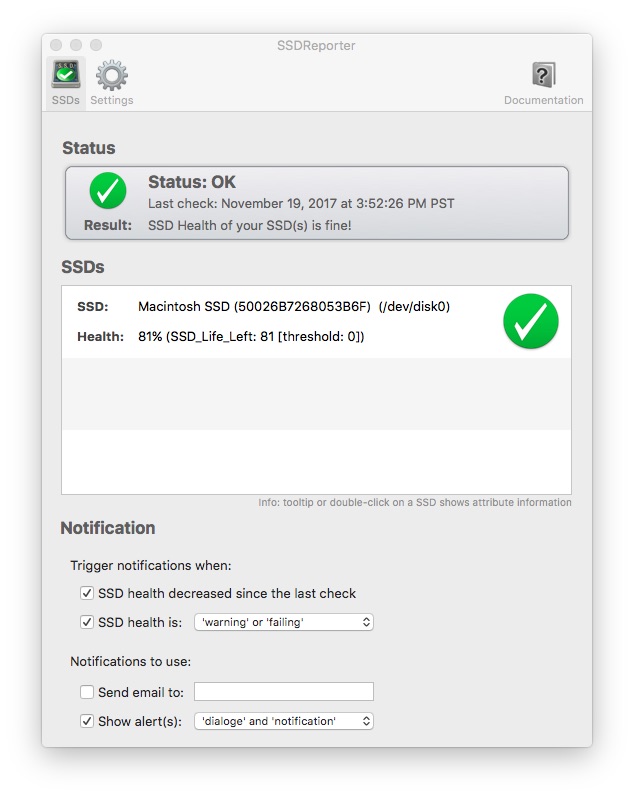
LINUX SSD HEALTH PRO
SEE: Securing Linux policy (Tech Pro Research) Usage Once the package is installed, you’re ready to go.
LINUX SSD HEALTH INSTALL
This can be installed with a single command:ĭo note, the above command will also install libgsasl7, libkyotocabinet16v5, libmailutils5, libntlm0, mailutils, mailutils-common, and postfix. The smartctl utility is a part of the smartmontools package. The required package is found on all the standard repositories, so adjust the installation command to fit your particular distribution of choice. I will be demonstrating with the Ubuntu platform (Ubuntu 17.10 to be exact). Even with that in mind, you can get a good estimation as to the wear and tear on your drives. Because of this, you cannot be certain the number of times your SSD chips have been written to. tools aren’t always up to date with every SSD drive.

Of course, how much mileage you get from the command will depend upon what make/model of SSD you employ. With this command, you can get a quick glimpse of your SSD health.

Why? Most of the time, your Linux servers won’t include a GUI with the command line, you can easily make use it by secure shelling into your remote Linux server and run your tests from the terminal. Although a GUI solution exists (GNOME Disks), I highly recommend going with a command line tool for this task. How do you check the health of those drives? As with everything in Linux, there are options. The last thing you want to do is fall victim to that particular end of days. Why? Because, even though solid state drives will dramatically outlast rotating platter drives, they do have a finite lifespan.
LINUX SSD HEALTH WINDOWS 10
Our 4 ways to check if your Windows 10 laptop has SSD guide might also interest you.If your data center makes use of Linux machines, one of the administrative tasks you’ll want to undertake is regularly checking the health of the SSD drives used on those machines. Step 5: The Drive health section displays the estimated remaining life of the hard drive or SSD, available spare, and current SSD temperature in degrees Celsius.īy the way, we advise you to always back up your data to a cloud storage service or external drive to avoid data loss. NOTE: If you have multiple SSDs on your computer, please scroll down the page to see all entries. Click on the hard drive or SSD entry to reveal the hidden Properties button. Step 3: The resulting page will display the number of drives and partitions on your PC. Step 2: In the More storage settings section, click on the Manage Disks and Volumes link. Check NVMe SSD estimated remaining life & temperature in Windows 10 IMPORTANT: The feature currently supports NVMe SSDs only. To check the build number, type winver.exe in Start/taskbar search and press Enter key. NOTE: As said at the beginning of the post, this is a new feature currently available to users testing Windows 10 Insider builds (20226 and above) only.

It only indicates that the drive has completed write/erase cycles predicted by the manufacturer.

Also, note that if Windows 10 displays the estimated remaining life of an SSD as 0%, that does not necessarily mean that the SSD has failed or about to die. How does Windows 10 calculate the estimated remaining life of SSDs?Īccording to Microsoft, Windows 10 uses approximate percent used of manufacturer’s prediction of drive life to calculate the estimated remaining life of SSDs. These features currently support only internal NVMe SSDs only. No, the temperature and health monitoring functions are not available for external drives such as pen drives and memory cards.
LINUX SSD HEALTH SOFTWARE
This means that you will not need to install third-party software to monitor the health of SSDs as Windows 10 also alerts users when the SSD is about to fail or its health deteriorates to a certain percentage. With the new feature, you can view the SSD health, available spare, and current temperature. The good thing is that Windows 10 now offers (currently available in Windows 10 Insider build number 20226 and above only) you view more information about SSDs. In addition to tools from SSD manufactures, there are numerous third-party applications around to monitor SSD health, performance, and temperature. For instance, Kingston provides a utility called SSD Manager, which lets you change various SSD settings, monitor the SSD health, and find other important information about SSD. Most SSD manufactures offer their own software to configure and monitor SSD health. Users who use computers to store critical data may want to review the health of SSDs from time to time to avoid data loss in case of storage device failure.


 0 kommentar(er)
0 kommentar(er)
